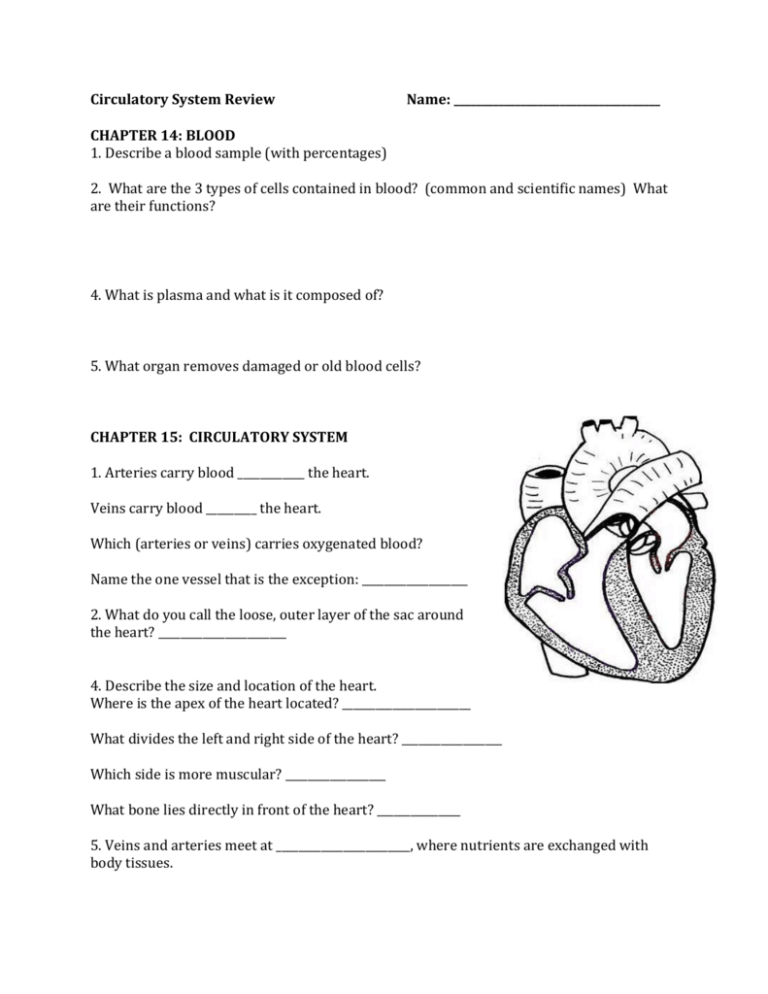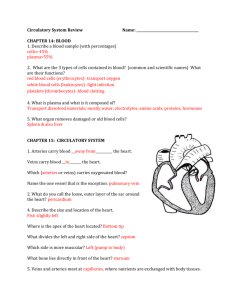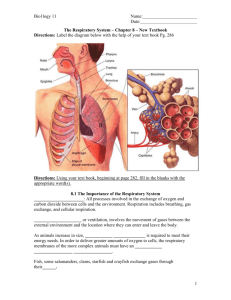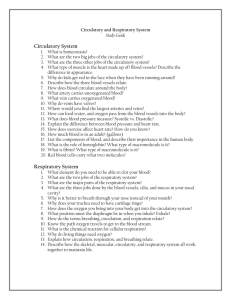CircRespReviewShort
advertisement

Circulatory System Review Name: _____________________________________ CHAPTER 14: BLOOD 1. Describe a blood sample (with percentages) 2. What are the 3 types of cells contained in blood? (common and scientific names) What are their functions? 4. What is plasma and what is it composed of? 5. What organ removes damaged or old blood cells? CHAPTER 15: CIRCULATORY SYSTEM 1. Arteries carry blood ____________ the heart. Veins carry blood _________ the heart. Which (arteries or veins) carries oxygenated blood? Name the one vessel that is the exception: ___________________ 2. What do you call the loose, outer layer of the sac around the heart? _______________________ 4. Describe the size and location of the heart. Where is the apex of the heart located? _______________________ What divides the left and right side of the heart? __________________ Which side is more muscular? __________________ What bone lies directly in front of the heart? _______________ 5. Veins and arteries meet at ________________________, where nutrients are exchanged with body tissues. 6. Describe the function of the sinoatrial node and trace the path of a nerve (cardiac) impulse through the cardiac conduction system. What is the pacemaker? ____________________________ 7. What are systolic pressure and diastolic pressure? What is the “normal” blood pressure for a human? 10. What two piece of equipment are needed to take a person’s blood pressure? Describe the procedure: 11. Blood that moves from the heart to the lungs and back to the heart again is in the _____________________ circuit. Blood moving throughout the body is in the ___________________ circuit. 12. Label all of the major vessels that attach to the heart. 13. Label a diagram of the heart and trace the flow of blood through the heart. Ch 19: RESPIRATORY SYSTEM REVIEW 1. What are the main functions of the respiratory system? 2. Name the organs of the upper respiratory tract? _________________________________________ lower respiratory tract? __________________________________________ 3. In what body cavity are the lungs located? __________________________________ 4. The taking in of air is called _______________________________ breathing out= ___________________ 5. The area located behind the oral cavity and between the nasal cavity and above the larynx is the __________________________ 6. Where does the trachea lie in relation to the esophagus? __________________________________ 7. What is the function of the hyaline cartilage of the trachea? ________________________________ 8. What protein combines with oxygen in the blood (for transport)? ________________________________ 9. What is the function of the nasal conchae? ____________________________________ 10. What is the triangular slit that opens and closes during talking called? ____________________ 11. Where is the respiratory center located? ________________________________________ 12. What structure resembles a bunch of grapes? _____________________________ 13. What is the function of the mucus membrane that lines the nasal cavities? 14. What happens when the diaphragm is lowered? ____________________________ 15. What part of the respiratory center is responsible for maintaining breathing patterns? ______________________ 16. Oxygen travels from the pharynx to the ________________________ to the _____________________ and finally to the ________________________ where oxygen is exchanged with the bloodstream. 19. What structure prevents food from entering the airway during swallowing? _________________________ 20. What fluid lubricates the lungs? ________________________________ 21. What is the main vessel the sends deoxygenated blood from the heart to the lungs? ______________________ 22. What is internal respiration? _________________________________________________ external respiration? ________________________________________________ 23. How does oxygen enter blood capillaries? _______________________ 24. Describe how a particular disorder affects the circulatory and respiratory systems.











